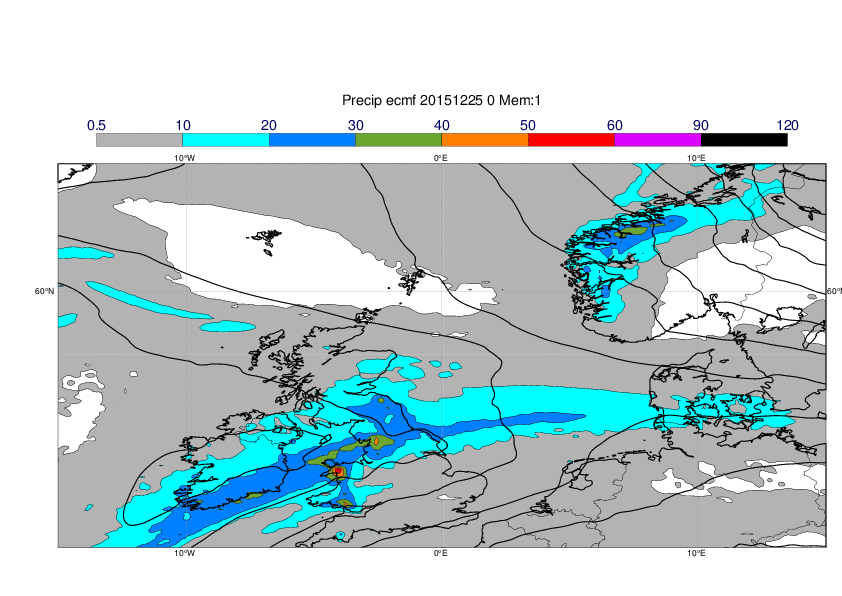...
The plots below show observations of 24-hour precipitation for the Christmas week 2015day-by-day from 18 December to 26 December.
After several episodes of heavy rainfall, the ground was already saturated when severe rainfall hit on Christmas Day (25) and Boxing Day (26). The rainfall was connected to a cyclone moving from south-west (see animation below).
The red arrow on the first frame of the animation shows schematically the rough trajectory of low level airmasses in the warm sector associated with low A. This warm, moist airmass seems to have fuelled the rain. SSTs, in what appears to be the approximate source region, NW of Morocco, are about 18-20C. From this region to the UK SSTs were about 0.5C above average.
Trying to disentangle the behaviour of lows/frontal waves during this event is difficult, though it is clear that one or more slow moving frontal zones lay over or just to the north of the main affected areas, and after low A had reached N Ireland, as a much 'weaker' feature, it seems that a new low formed as a wave, of sorts, on a cold front to the SW (labelled low B) and this then deepened for a while as it cross Ireland and S Scotland, becoming a small and quite intense low over the N Sea, before it too filled (after the period shown on the above animation) as it continued on ESE'wards into continental Europe.
So the The deepening of low B must have been associated with broadscale dynamical uplift, and that broadscale ascent, together with the close proximity of the frontal zone, the slow moving nature fo to the front due to multiple lows/wave movng moving along it, the warm airmass source region near Morocco, and some orographic enhancement seem to have all contrived, together, to deliver the high rainfall totals observed.
...
The animation below shows the observation rejection (low weight) charts for subsequent assimilation cycles. Wind observations with low weight is marked with symbols and the 250 hPa wind speed in the analysis is plotted with shades. The position of low A is marked with a black dot. On 23-24 December a cluster of observations were given low weight over U.S, probably connected to severe convection.
3.2 HRES
The plots below shows show the accumulated precipitation between 25 Dec 06z and 26 Dec 06z and MSLP valid 12z on 25 Dec. The forecasts from 24 December 12z and earlier the position of low A is too far too the west and the band of precipitation is shifted somewhat to the north.
O-suite:
E-suite:
The plots below shows show the accumulated precipitation between 26 Dec 06z and 27 Dec 06z. In the forecast from 24 December 12z and earlier the handling of low is poor.
...
There is a modest EFI signal early on, which becomes weaker, before suddenly reasserting itself just before the event. This would have hindered rather than helped forecasters, particularly in the medium range where we are relied upon most for gudianceguidance. This impression is echoed somewhat by the CDF plot, which jumps to higher totals in the penultimate (Fri 12Z = purple) forecast.
...
The plots below shows ensemble mean seasonal forecasts anomalies for December. The plots include precipitation (shade) and surface wind anomaly (arrows). The forecasts are from 1 Dec, 1 Nov, 1 Oct, 1 Sept and 1 Aug. All forecasts shows sign of wet anomalies for north-western Europe and stronger-than-normal westerly flow (positive NAO).
3.5 Comparison with other centres
3.6 EFAS
4. Experience from general performance/other cases
- The flooding earlier in December - 201512 - Rainfall - British Isles
5. Good and bad aspects of the forecasts for the event
...






























